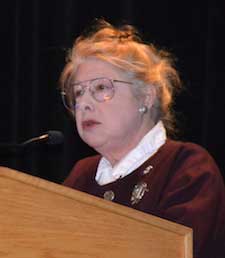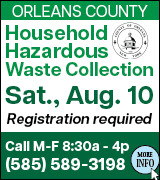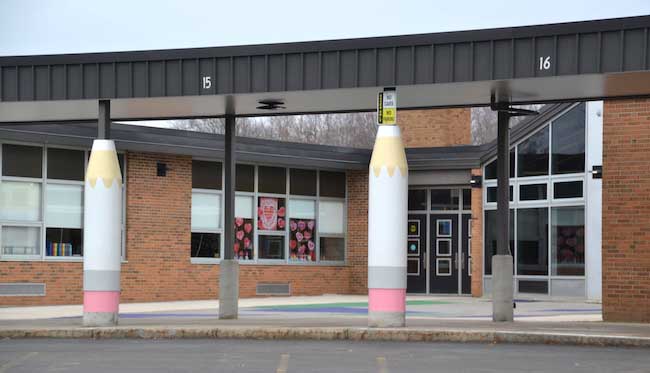Air-quality survey of Albion elementary building shows no significant issues tied to cancer concerns
ALBION – An expert did an indoor air investigation of the Ronald L. Sodoma Elementary School and found no significant issues that would account for a high rate of breast cancer.
The Albion Teachers Association has been pushing for an environmental assessment of the building. The ATA said there is a high breast cancer rate among the teachers and staff.
The ATA in May told the Board of Education that the ATA counted 25 teachers and staff who have been diagnosed with breast cancer. That includes cafeteria workers, clerical staff and teacher aides, as well as teachers.

Nellie Brown speaks during a community meeting in Albion on Jan. 31, 2019.
The district reached out to Nellie Brown, director of the Workplace Health and Safety Program for Cornell University’s School of Industrial and Labor Relations, for the indoor air study.
Brown was at the district on Sept. 23 and Sept. 30 for an indoor air investigation of the school building, which is 179,300 square feet. The original school was built in 1957 with remodeling in 1965, 1985, 2000-2002, and 2004. The building occupancy includes 850 students and 98 staff.
Brown’s report was given to the school on Jan. 17. The Board of Education discussed it during its meeting on Monday.
“In general, our building was well built, has been well cared for and well maintained,” said Michael Bonnewell, the district superintendent.
The district will give the report to James Bowers, an epidemiologist who studies diseases for the state Department of Health.
Kathy Harling, the Board of Education president, said she was pleased with the findings in the report.
Brown in her investigation focused on five areas:
1. Insufficient ventilation: The carbon dioxide measurements showed there is sufficient ventilation, and temperature and humidity meet requirements by the ASHRAE (American Society of Heating, Refrigerating and Air-Conditioning Engineers).
Brown did suggest that the district’s buildings and grounds staff mow grass away from uninvent air intakes. (There were some grass clippings on the air intakes at courtyard A and B.)
Brown also made other observations: no HVAC at the band office, room G7 has an air-conditioner but no ventilation; An AccuTemp oven should be moved further down the range hood for better exhaust; Room J11 restroom exhaust vent draws poorly – the vent screen is covered in lint and needs regular cleaning; Both the boys’ and girls’ locker rooms exhaust have little to no flow – the system needs to be evaluated for operation; Restroom exhausts for J1 and J2 had slow flow – all other restroom exhausts worked well.
2. Inside sources of air contaminants: Consider upgrading vacuum cleaners to HEPA (High-Efficiency Particulate Air) if not already using. Recommendations were made to discontinue products/dispensers of perfumes and fragrances, and to discourage the use of products not purchased through the school district’s purchasing program. (The district buys environmentally products from the “green list” but some teachers and staff were bringing in their own cleaning products.)
3. Outside sources of air contaminants: No significant issues.
4. Biological sources of air contaminants: There have been historical water problems. Carpeted classrooms have carpet right up to the sinks/water fountains. The infrared moisture meter indicated numerous rooms with drips and splashes of water on the carpet. As moist areas can lead to mold or bacterial growth, it is desirable to have hard flooring in front of sinks/water fountains.
Removable, cleanable floor mats could be located at exterior doors; this is very useful to stop dirt and moisture being tracked into the building where they can provide habitat for fungal growth in carpets.
Water stains were observed on the ceiling in several rooms. While these were found to be nonactive as per the infrared moisture meter, potential sources of the moisture should be identified and resolved. Care should be taken to make sure that moisture from watering plants does not wet carpet so as to prevent fungal growth in carpet. Plants should not be allowed to drop debris into the univents.
5. Building fabric sources of air contaminants: No significant issues.
(Click here to see Brown’s more detailed report from her investigation. You have to scroll through the information from Monday’s Board of Education meeting to get to the report.)
Bonnewell said the district has already addressed many of Brown’s findings. The district hasn’t yet replaced carpeting with tile by sinks in classrooms. Bonnewell said there is some concern that tile could be slippery if it gets wet.
Brown also met previously with the cleaners and buildings and grounds staff to over the materials they use for cleaning the school. She provided an indoor environment training program to staff on April 12 and June 10.
Brown also spoke for an hour during a community meeting on Jan. 31, 2019, outlining numerous chemicals that can be potential causes of breast cancer or endocrine disrupters.
Brown, during that meeting last January, said determining the causes of elevated breast cancer rates is challenging due to the complexity of the disease and many risk factors involved. It also takes a long time for breast tumors to develop, at least a decade after an exposure to a carcinogen.
(Click here to see an Orleans Hub article from Feb. 1, 2019, headlined, “No easy answers in determining if Albion teachers have elevated cancer rate.”)

















































































